Gas Pipeline Construction Management in Australia: A Report
VerifiedAdded on 2020/03/01
|19
|5961
|39
Report
AI Summary
This report provides a comprehensive analysis of gas pipeline construction in Australia, focusing on engineering management and operational practices. It begins with an introduction to the onshore pipeline industry and its significance in meeting Australia's energy needs, emphasizing the role of the Australian Pipeline & Gas Association (APGA) in ensuring safety and health standards. The report details the operational procedures of Esso Australia Resources Pty Ltd in pipeline construction, including landowner consultations, pre-construction surveys, and the construction processes such as clearing, welding, and trenching. It also reviews the processes for natural gas pipeline construction and storage, highlighting Australia's increasing natural gas production. The report includes a reference list, a mind map, and a literature planner with summaries of journal articles related to gas pipeline construction, discussing research questions, themes, findings, and gaps in the literature, providing insights into the design, construction, and regulation of gas pipelines in Australia.
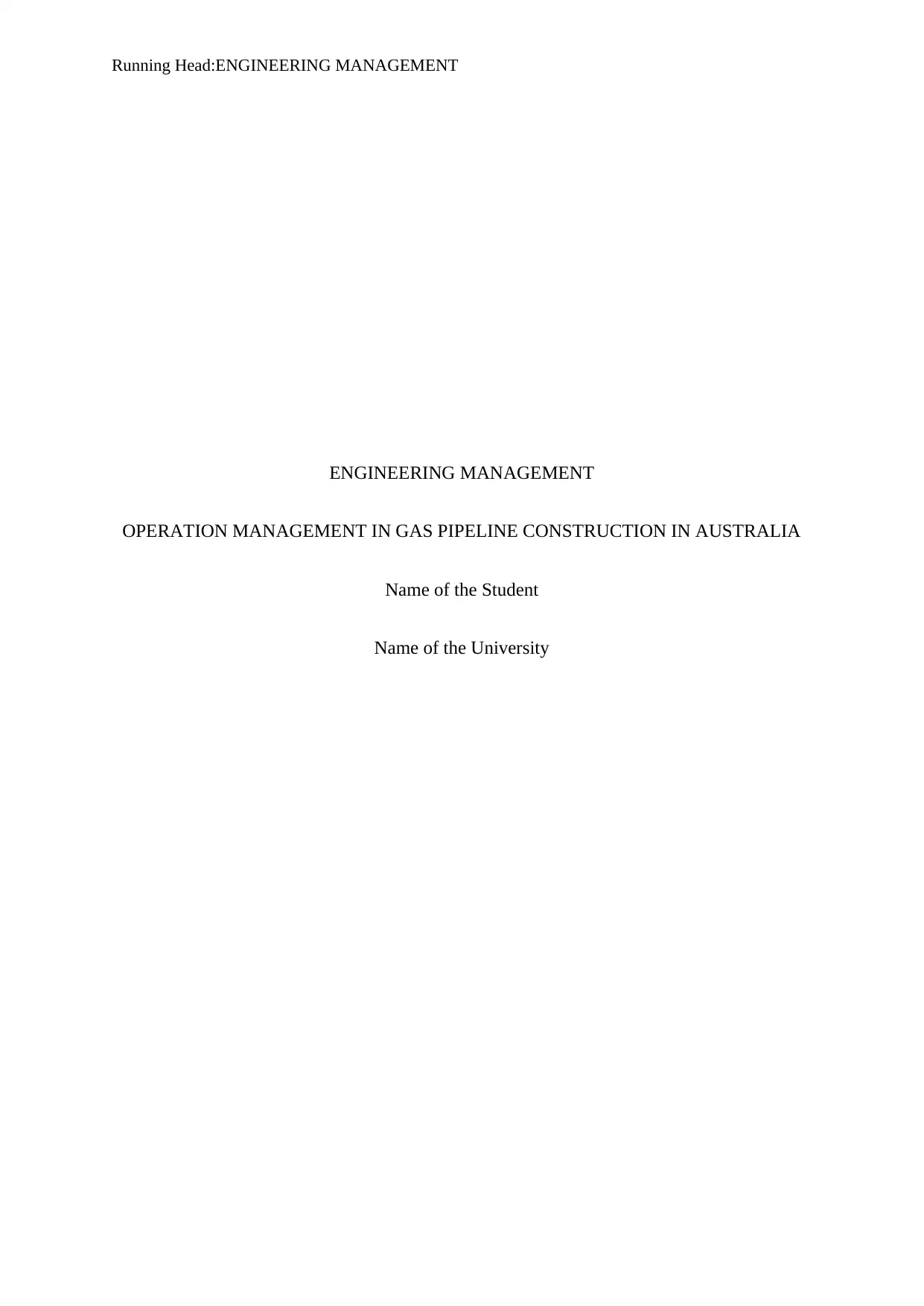
Running Head:ENGINEERING MANAGEMENT
ENGINEERING MANAGEMENT
OPERATION MANAGEMENT IN GAS PIPELINE CONSTRUCTION IN AUSTRALIA
Name of the Student
Name of the University
ENGINEERING MANAGEMENT
OPERATION MANAGEMENT IN GAS PIPELINE CONSTRUCTION IN AUSTRALIA
Name of the Student
Name of the University
Paraphrase This Document
Need a fresh take? Get an instant paraphrase of this document with our AI Paraphraser
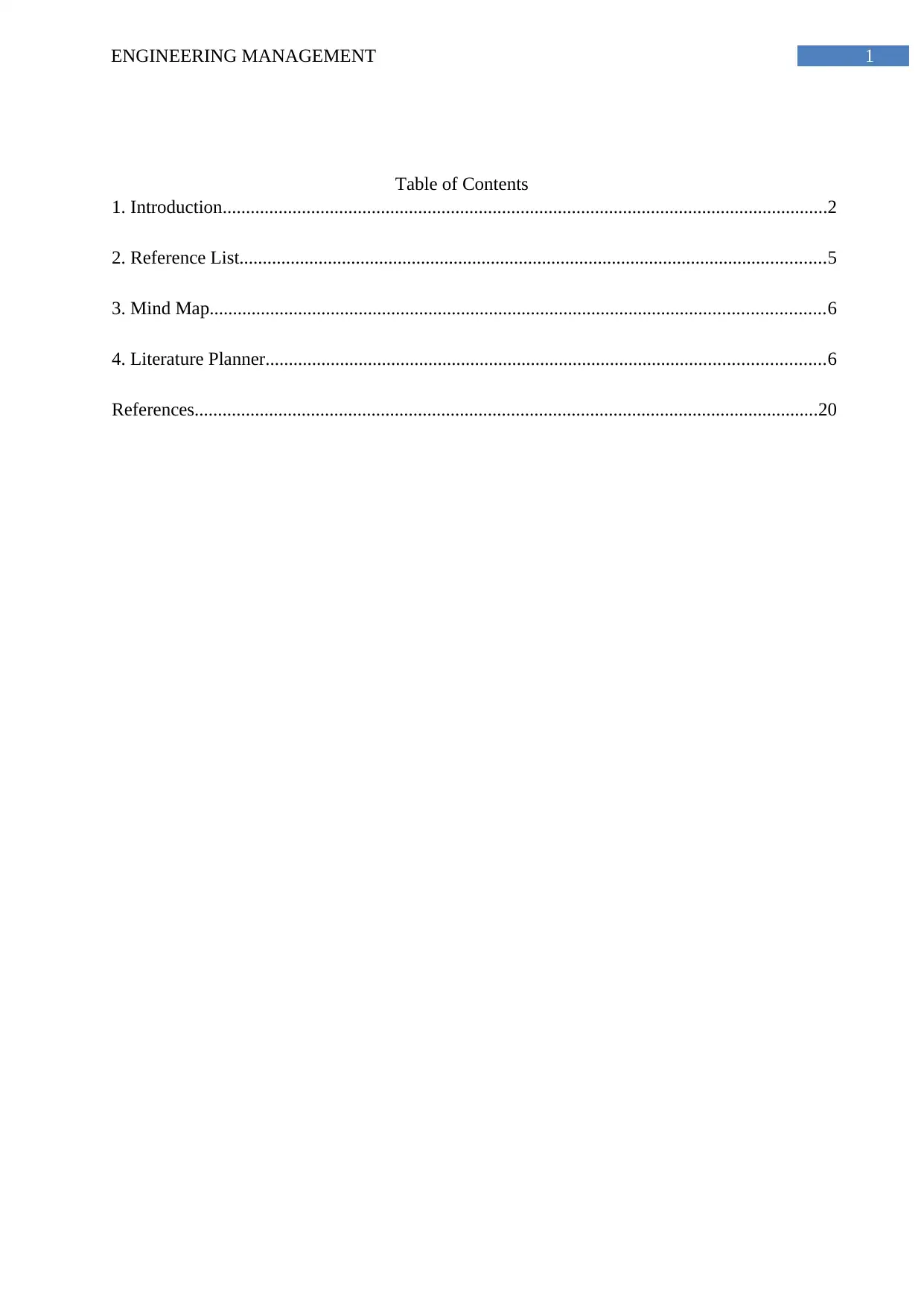
1ENGINEERING MANAGEMENT
Table of Contents
1. Introduction..................................................................................................................................2
2. Reference List..............................................................................................................................5
3. Mind Map....................................................................................................................................6
4. Literature Planner........................................................................................................................6
References......................................................................................................................................20
Table of Contents
1. Introduction..................................................................................................................................2
2. Reference List..............................................................................................................................5
3. Mind Map....................................................................................................................................6
4. Literature Planner........................................................................................................................6
References......................................................................................................................................20
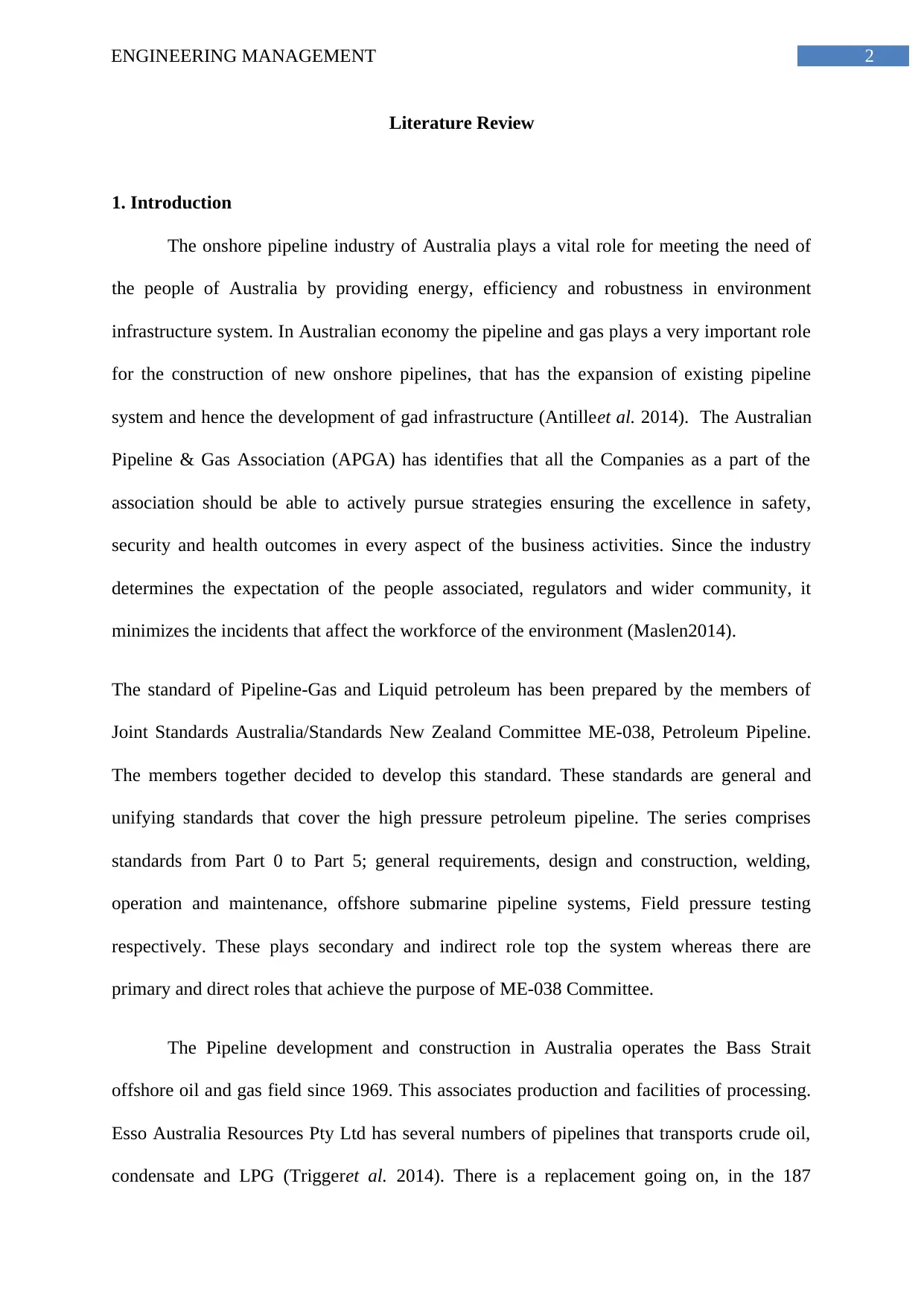
2ENGINEERING MANAGEMENT
Literature Review
1. Introduction
The onshore pipeline industry of Australia plays a vital role for meeting the need of
the people of Australia by providing energy, efficiency and robustness in environment
infrastructure system. In Australian economy the pipeline and gas plays a very important role
for the construction of new onshore pipelines, that has the expansion of existing pipeline
system and hence the development of gad infrastructure (Antilleet al. 2014). The Australian
Pipeline & Gas Association (APGA) has identifies that all the Companies as a part of the
association should be able to actively pursue strategies ensuring the excellence in safety,
security and health outcomes in every aspect of the business activities. Since the industry
determines the expectation of the people associated, regulators and wider community, it
minimizes the incidents that affect the workforce of the environment (Maslen2014).
The standard of Pipeline-Gas and Liquid petroleum has been prepared by the members of
Joint Standards Australia/Standards New Zealand Committee ME-038, Petroleum Pipeline.
The members together decided to develop this standard. These standards are general and
unifying standards that cover the high pressure petroleum pipeline. The series comprises
standards from Part 0 to Part 5; general requirements, design and construction, welding,
operation and maintenance, offshore submarine pipeline systems, Field pressure testing
respectively. These plays secondary and indirect role top the system whereas there are
primary and direct roles that achieve the purpose of ME-038 Committee.
The Pipeline development and construction in Australia operates the Bass Strait
offshore oil and gas field since 1969. This associates production and facilities of processing.
Esso Australia Resources Pty Ltd has several numbers of pipelines that transports crude oil,
condensate and LPG (Triggeret al. 2014). There is a replacement going on, in the 187
Literature Review
1. Introduction
The onshore pipeline industry of Australia plays a vital role for meeting the need of
the people of Australia by providing energy, efficiency and robustness in environment
infrastructure system. In Australian economy the pipeline and gas plays a very important role
for the construction of new onshore pipelines, that has the expansion of existing pipeline
system and hence the development of gad infrastructure (Antilleet al. 2014). The Australian
Pipeline & Gas Association (APGA) has identifies that all the Companies as a part of the
association should be able to actively pursue strategies ensuring the excellence in safety,
security and health outcomes in every aspect of the business activities. Since the industry
determines the expectation of the people associated, regulators and wider community, it
minimizes the incidents that affect the workforce of the environment (Maslen2014).
The standard of Pipeline-Gas and Liquid petroleum has been prepared by the members of
Joint Standards Australia/Standards New Zealand Committee ME-038, Petroleum Pipeline.
The members together decided to develop this standard. These standards are general and
unifying standards that cover the high pressure petroleum pipeline. The series comprises
standards from Part 0 to Part 5; general requirements, design and construction, welding,
operation and maintenance, offshore submarine pipeline systems, Field pressure testing
respectively. These plays secondary and indirect role top the system whereas there are
primary and direct roles that achieve the purpose of ME-038 Committee.
The Pipeline development and construction in Australia operates the Bass Strait
offshore oil and gas field since 1969. This associates production and facilities of processing.
Esso Australia Resources Pty Ltd has several numbers of pipelines that transports crude oil,
condensate and LPG (Triggeret al. 2014). There is a replacement going on, in the 187
⊘ This is a preview!⊘
Do you want full access?
Subscribe today to unlock all pages.

Trusted by 1+ million students worldwide
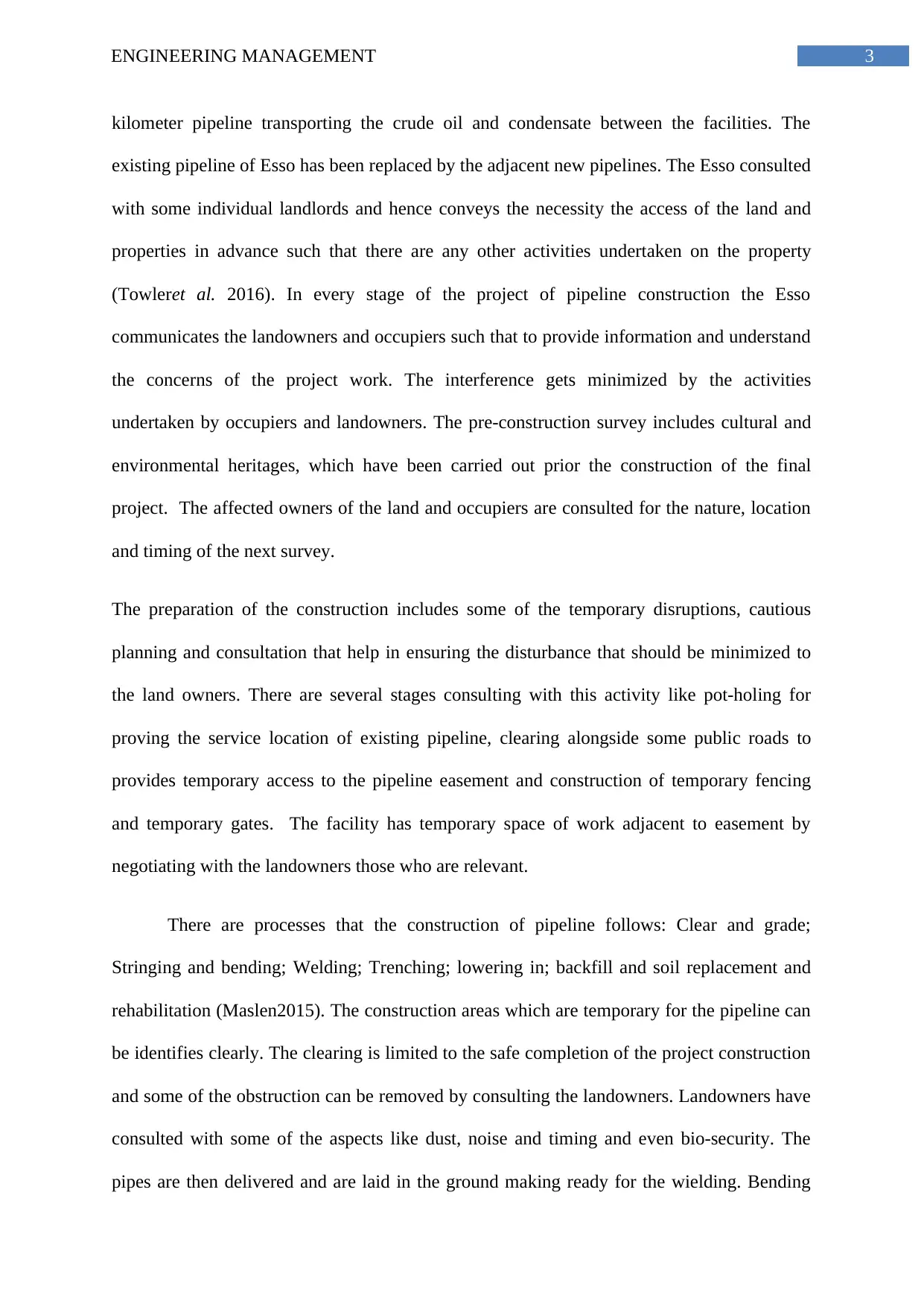
3ENGINEERING MANAGEMENT
kilometer pipeline transporting the crude oil and condensate between the facilities. The
existing pipeline of Esso has been replaced by the adjacent new pipelines. The Esso consulted
with some individual landlords and hence conveys the necessity the access of the land and
properties in advance such that there are any other activities undertaken on the property
(Towleret al. 2016). In every stage of the project of pipeline construction the Esso
communicates the landowners and occupiers such that to provide information and understand
the concerns of the project work. The interference gets minimized by the activities
undertaken by occupiers and landowners. The pre-construction survey includes cultural and
environmental heritages, which have been carried out prior the construction of the final
project. The affected owners of the land and occupiers are consulted for the nature, location
and timing of the next survey.
The preparation of the construction includes some of the temporary disruptions, cautious
planning and consultation that help in ensuring the disturbance that should be minimized to
the land owners. There are several stages consulting with this activity like pot-holing for
proving the service location of existing pipeline, clearing alongside some public roads to
provides temporary access to the pipeline easement and construction of temporary fencing
and temporary gates. The facility has temporary space of work adjacent to easement by
negotiating with the landowners those who are relevant.
There are processes that the construction of pipeline follows: Clear and grade;
Stringing and bending; Welding; Trenching; lowering in; backfill and soil replacement and
rehabilitation (Maslen2015). The construction areas which are temporary for the pipeline can
be identifies clearly. The clearing is limited to the safe completion of the project construction
and some of the obstruction can be removed by consulting the landowners. Landowners have
consulted with some of the aspects like dust, noise and timing and even bio-security. The
pipes are then delivered and are laid in the ground making ready for the wielding. Bending
kilometer pipeline transporting the crude oil and condensate between the facilities. The
existing pipeline of Esso has been replaced by the adjacent new pipelines. The Esso consulted
with some individual landlords and hence conveys the necessity the access of the land and
properties in advance such that there are any other activities undertaken on the property
(Towleret al. 2016). In every stage of the project of pipeline construction the Esso
communicates the landowners and occupiers such that to provide information and understand
the concerns of the project work. The interference gets minimized by the activities
undertaken by occupiers and landowners. The pre-construction survey includes cultural and
environmental heritages, which have been carried out prior the construction of the final
project. The affected owners of the land and occupiers are consulted for the nature, location
and timing of the next survey.
The preparation of the construction includes some of the temporary disruptions, cautious
planning and consultation that help in ensuring the disturbance that should be minimized to
the land owners. There are several stages consulting with this activity like pot-holing for
proving the service location of existing pipeline, clearing alongside some public roads to
provides temporary access to the pipeline easement and construction of temporary fencing
and temporary gates. The facility has temporary space of work adjacent to easement by
negotiating with the landowners those who are relevant.
There are processes that the construction of pipeline follows: Clear and grade;
Stringing and bending; Welding; Trenching; lowering in; backfill and soil replacement and
rehabilitation (Maslen2015). The construction areas which are temporary for the pipeline can
be identifies clearly. The clearing is limited to the safe completion of the project construction
and some of the obstruction can be removed by consulting the landowners. Landowners have
consulted with some of the aspects like dust, noise and timing and even bio-security. The
pipes are then delivered and are laid in the ground making ready for the wielding. Bending
Paraphrase This Document
Need a fresh take? Get an instant paraphrase of this document with our AI Paraphraser
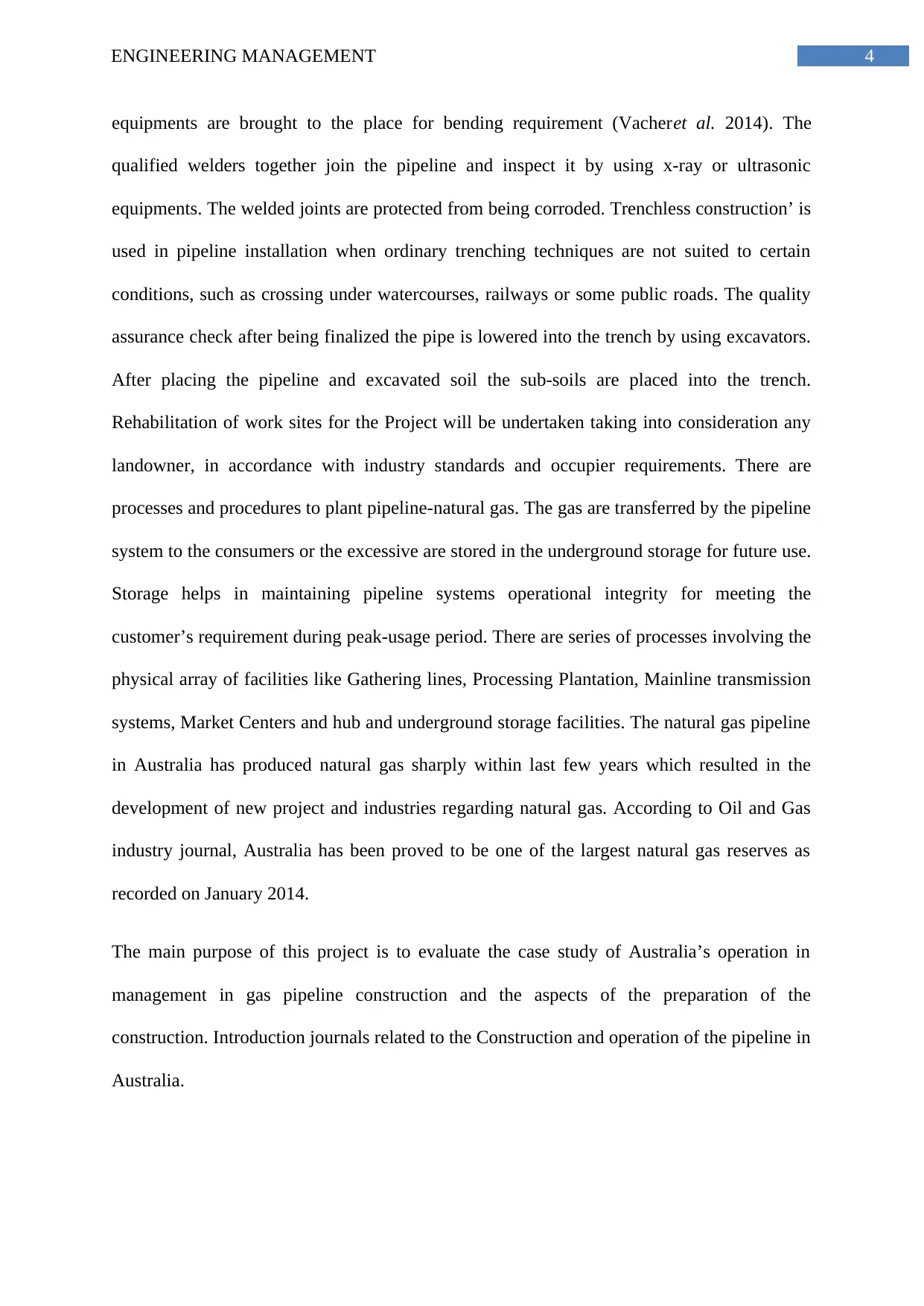
4ENGINEERING MANAGEMENT
equipments are brought to the place for bending requirement (Vacheret al. 2014). The
qualified welders together join the pipeline and inspect it by using x-ray or ultrasonic
equipments. The welded joints are protected from being corroded. Trenchless construction’ is
used in pipeline installation when ordinary trenching techniques are not suited to certain
conditions, such as crossing under watercourses, railways or some public roads. The quality
assurance check after being finalized the pipe is lowered into the trench by using excavators.
After placing the pipeline and excavated soil the sub-soils are placed into the trench.
Rehabilitation of work sites for the Project will be undertaken taking into consideration any
landowner, in accordance with industry standards and occupier requirements. There are
processes and procedures to plant pipeline-natural gas. The gas are transferred by the pipeline
system to the consumers or the excessive are stored in the underground storage for future use.
Storage helps in maintaining pipeline systems operational integrity for meeting the
customer’s requirement during peak-usage period. There are series of processes involving the
physical array of facilities like Gathering lines, Processing Plantation, Mainline transmission
systems, Market Centers and hub and underground storage facilities. The natural gas pipeline
in Australia has produced natural gas sharply within last few years which resulted in the
development of new project and industries regarding natural gas. According to Oil and Gas
industry journal, Australia has been proved to be one of the largest natural gas reserves as
recorded on January 2014.
The main purpose of this project is to evaluate the case study of Australia’s operation in
management in gas pipeline construction and the aspects of the preparation of the
construction. Introduction journals related to the Construction and operation of the pipeline in
Australia.
equipments are brought to the place for bending requirement (Vacheret al. 2014). The
qualified welders together join the pipeline and inspect it by using x-ray or ultrasonic
equipments. The welded joints are protected from being corroded. Trenchless construction’ is
used in pipeline installation when ordinary trenching techniques are not suited to certain
conditions, such as crossing under watercourses, railways or some public roads. The quality
assurance check after being finalized the pipe is lowered into the trench by using excavators.
After placing the pipeline and excavated soil the sub-soils are placed into the trench.
Rehabilitation of work sites for the Project will be undertaken taking into consideration any
landowner, in accordance with industry standards and occupier requirements. There are
processes and procedures to plant pipeline-natural gas. The gas are transferred by the pipeline
system to the consumers or the excessive are stored in the underground storage for future use.
Storage helps in maintaining pipeline systems operational integrity for meeting the
customer’s requirement during peak-usage period. There are series of processes involving the
physical array of facilities like Gathering lines, Processing Plantation, Mainline transmission
systems, Market Centers and hub and underground storage facilities. The natural gas pipeline
in Australia has produced natural gas sharply within last few years which resulted in the
development of new project and industries regarding natural gas. According to Oil and Gas
industry journal, Australia has been proved to be one of the largest natural gas reserves as
recorded on January 2014.
The main purpose of this project is to evaluate the case study of Australia’s operation in
management in gas pipeline construction and the aspects of the preparation of the
construction. Introduction journals related to the Construction and operation of the pipeline in
Australia.
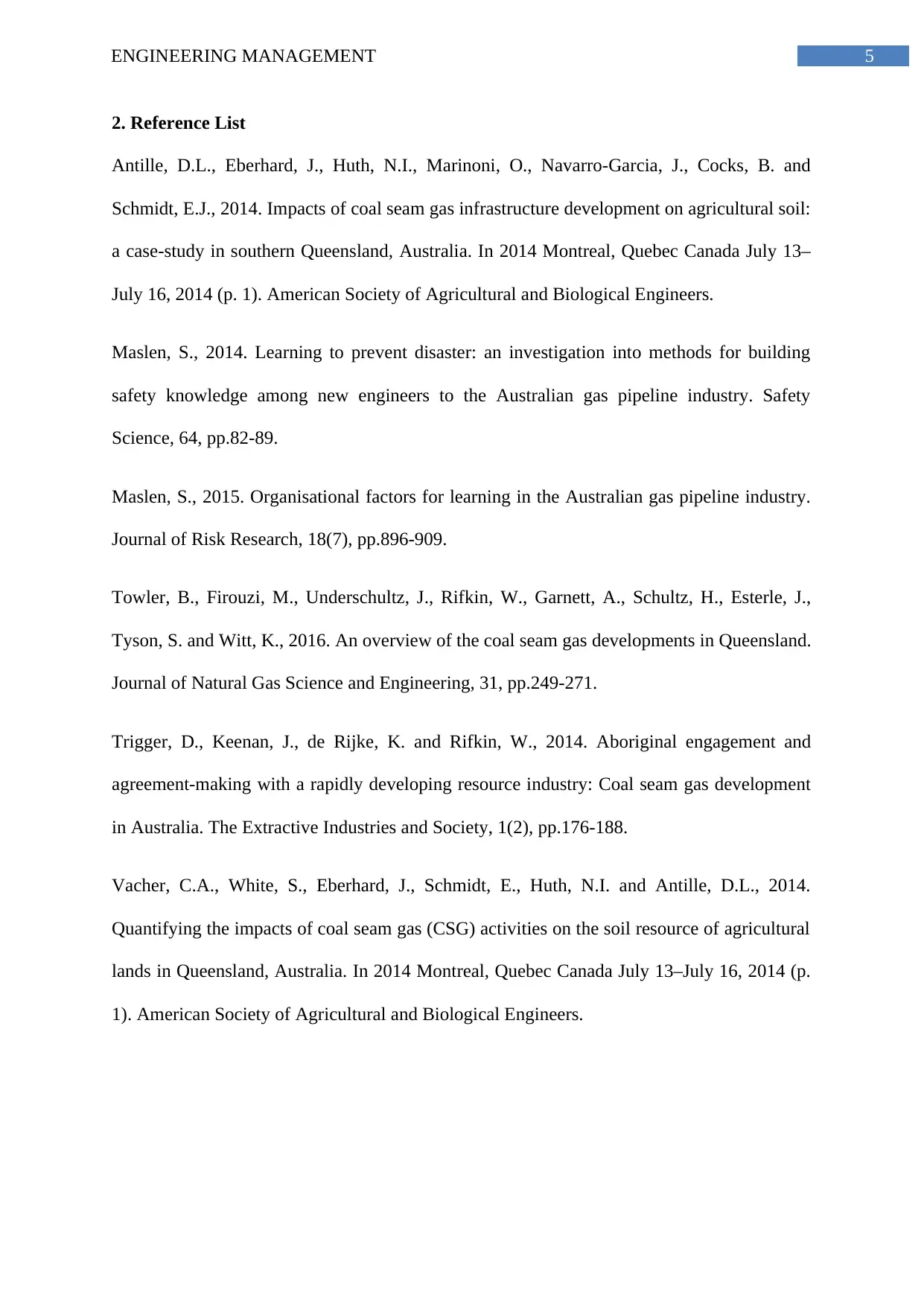
5ENGINEERING MANAGEMENT
2. Reference List
Antille, D.L., Eberhard, J., Huth, N.I., Marinoni, O., Navarro-Garcia, J., Cocks, B. and
Schmidt, E.J., 2014. Impacts of coal seam gas infrastructure development on agricultural soil:
a case-study in southern Queensland, Australia. In 2014 Montreal, Quebec Canada July 13–
July 16, 2014 (p. 1). American Society of Agricultural and Biological Engineers.
Maslen, S., 2014. Learning to prevent disaster: an investigation into methods for building
safety knowledge among new engineers to the Australian gas pipeline industry. Safety
Science, 64, pp.82-89.
Maslen, S., 2015. Organisational factors for learning in the Australian gas pipeline industry.
Journal of Risk Research, 18(7), pp.896-909.
Towler, B., Firouzi, M., Underschultz, J., Rifkin, W., Garnett, A., Schultz, H., Esterle, J.,
Tyson, S. and Witt, K., 2016. An overview of the coal seam gas developments in Queensland.
Journal of Natural Gas Science and Engineering, 31, pp.249-271.
Trigger, D., Keenan, J., de Rijke, K. and Rifkin, W., 2014. Aboriginal engagement and
agreement-making with a rapidly developing resource industry: Coal seam gas development
in Australia. The Extractive Industries and Society, 1(2), pp.176-188.
Vacher, C.A., White, S., Eberhard, J., Schmidt, E., Huth, N.I. and Antille, D.L., 2014.
Quantifying the impacts of coal seam gas (CSG) activities on the soil resource of agricultural
lands in Queensland, Australia. In 2014 Montreal, Quebec Canada July 13–July 16, 2014 (p.
1). American Society of Agricultural and Biological Engineers.
2. Reference List
Antille, D.L., Eberhard, J., Huth, N.I., Marinoni, O., Navarro-Garcia, J., Cocks, B. and
Schmidt, E.J., 2014. Impacts of coal seam gas infrastructure development on agricultural soil:
a case-study in southern Queensland, Australia. In 2014 Montreal, Quebec Canada July 13–
July 16, 2014 (p. 1). American Society of Agricultural and Biological Engineers.
Maslen, S., 2014. Learning to prevent disaster: an investigation into methods for building
safety knowledge among new engineers to the Australian gas pipeline industry. Safety
Science, 64, pp.82-89.
Maslen, S., 2015. Organisational factors for learning in the Australian gas pipeline industry.
Journal of Risk Research, 18(7), pp.896-909.
Towler, B., Firouzi, M., Underschultz, J., Rifkin, W., Garnett, A., Schultz, H., Esterle, J.,
Tyson, S. and Witt, K., 2016. An overview of the coal seam gas developments in Queensland.
Journal of Natural Gas Science and Engineering, 31, pp.249-271.
Trigger, D., Keenan, J., de Rijke, K. and Rifkin, W., 2014. Aboriginal engagement and
agreement-making with a rapidly developing resource industry: Coal seam gas development
in Australia. The Extractive Industries and Society, 1(2), pp.176-188.
Vacher, C.A., White, S., Eberhard, J., Schmidt, E., Huth, N.I. and Antille, D.L., 2014.
Quantifying the impacts of coal seam gas (CSG) activities on the soil resource of agricultural
lands in Queensland, Australia. In 2014 Montreal, Quebec Canada July 13–July 16, 2014 (p.
1). American Society of Agricultural and Biological Engineers.
⊘ This is a preview!⊘
Do you want full access?
Subscribe today to unlock all pages.

Trusted by 1+ million students worldwide
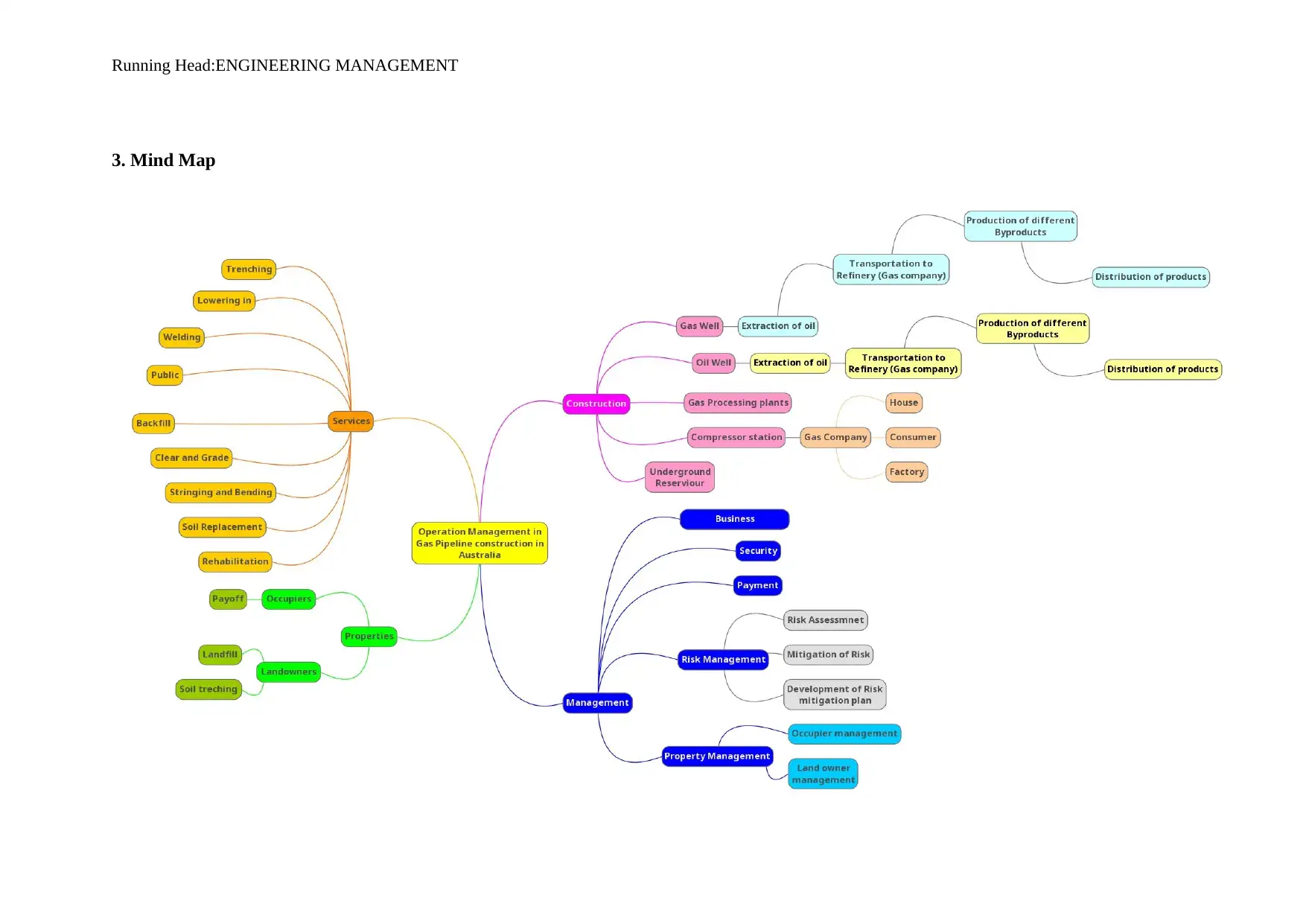
Running Head:ENGINEERING MANAGEMENT
3. Mind Map
3. Mind Map
Paraphrase This Document
Need a fresh take? Get an instant paraphrase of this document with our AI Paraphraser
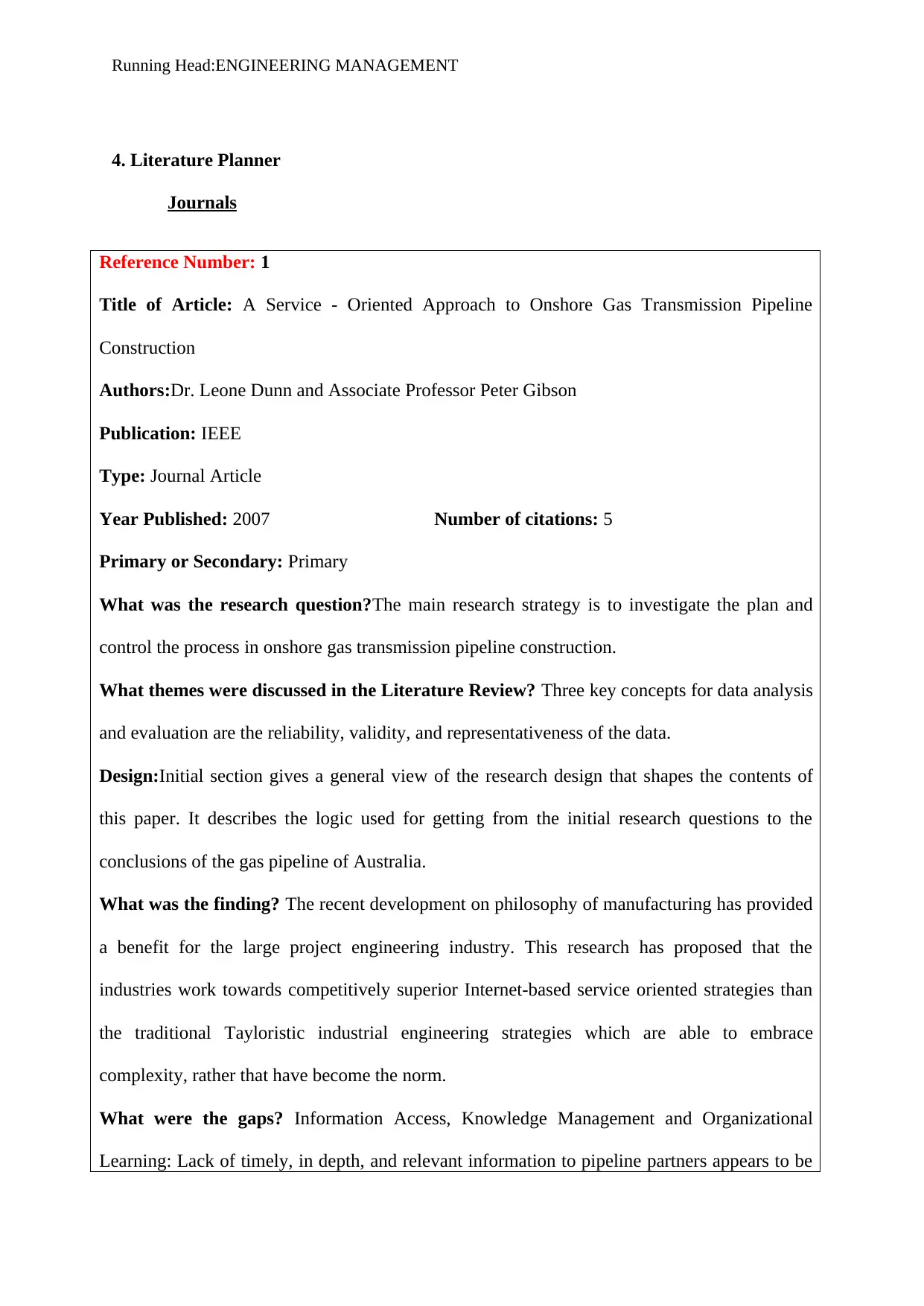
Running Head:ENGINEERING MANAGEMENT
4. Literature Planner
Journals
Reference Number: 1
Title of Article: A Service - Oriented Approach to Onshore Gas Transmission Pipeline
Construction
Authors:Dr. Leone Dunn and Associate Professor Peter Gibson
Publication: IEEE
Type: Journal Article
Year Published: 2007 Number of citations: 5
Primary or Secondary: Primary
What was the research question?The main research strategy is to investigate the plan and
control the process in onshore gas transmission pipeline construction.
What themes were discussed in the Literature Review? Three key concepts for data analysis
and evaluation are the reliability, validity, and representativeness of the data.
Design:Initial section gives a general view of the research design that shapes the contents of
this paper. It describes the logic used for getting from the initial research questions to the
conclusions of the gas pipeline of Australia.
What was the finding? The recent development on philosophy of manufacturing has provided
a benefit for the large project engineering industry. This research has proposed that the
industries work towards competitively superior Internet-based service oriented strategies than
the traditional Tayloristic industrial engineering strategies which are able to embrace
complexity, rather that have become the norm.
What were the gaps? Information Access, Knowledge Management and Organizational
Learning: Lack of timely, in depth, and relevant information to pipeline partners appears to be
4. Literature Planner
Journals
Reference Number: 1
Title of Article: A Service - Oriented Approach to Onshore Gas Transmission Pipeline
Construction
Authors:Dr. Leone Dunn and Associate Professor Peter Gibson
Publication: IEEE
Type: Journal Article
Year Published: 2007 Number of citations: 5
Primary or Secondary: Primary
What was the research question?The main research strategy is to investigate the plan and
control the process in onshore gas transmission pipeline construction.
What themes were discussed in the Literature Review? Three key concepts for data analysis
and evaluation are the reliability, validity, and representativeness of the data.
Design:Initial section gives a general view of the research design that shapes the contents of
this paper. It describes the logic used for getting from the initial research questions to the
conclusions of the gas pipeline of Australia.
What was the finding? The recent development on philosophy of manufacturing has provided
a benefit for the large project engineering industry. This research has proposed that the
industries work towards competitively superior Internet-based service oriented strategies than
the traditional Tayloristic industrial engineering strategies which are able to embrace
complexity, rather that have become the norm.
What were the gaps? Information Access, Knowledge Management and Organizational
Learning: Lack of timely, in depth, and relevant information to pipeline partners appears to be
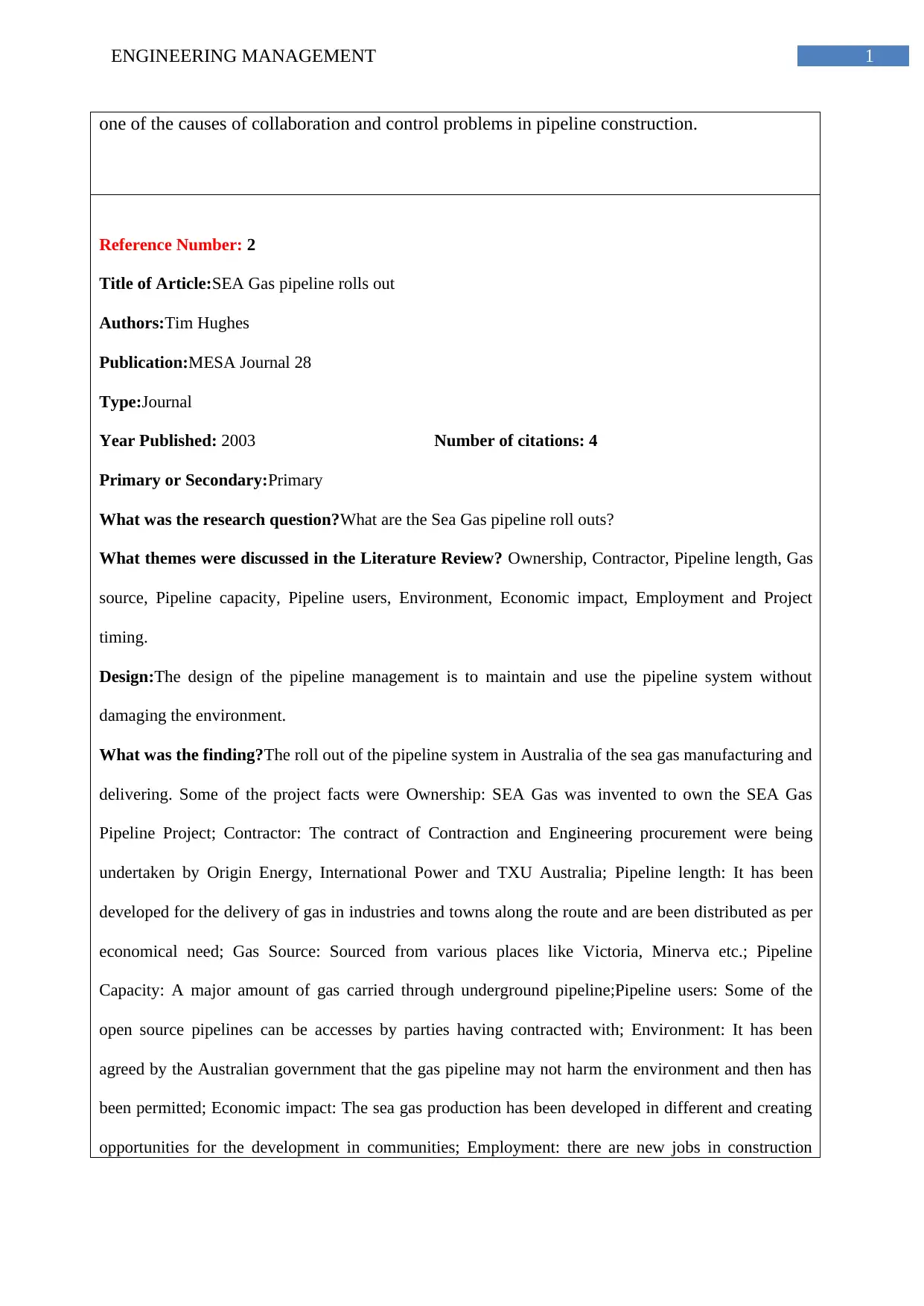
1ENGINEERING MANAGEMENT
one of the causes of collaboration and control problems in pipeline construction.
Reference Number: 2
Title of Article:SEA Gas pipeline rolls out
Authors:Tim Hughes
Publication:MESA Journal 28
Type:Journal
Year Published: 2003 Number of citations: 4
Primary or Secondary:Primary
What was the research question?What are the Sea Gas pipeline roll outs?
What themes were discussed in the Literature Review? Ownership, Contractor, Pipeline length, Gas
source, Pipeline capacity, Pipeline users, Environment, Economic impact, Employment and Project
timing.
Design:The design of the pipeline management is to maintain and use the pipeline system without
damaging the environment.
What was the finding?The roll out of the pipeline system in Australia of the sea gas manufacturing and
delivering. Some of the project facts were Ownership: SEA Gas was invented to own the SEA Gas
Pipeline Project; Contractor: The contract of Contraction and Engineering procurement were being
undertaken by Origin Energy, International Power and TXU Australia; Pipeline length: It has been
developed for the delivery of gas in industries and towns along the route and are been distributed as per
economical need; Gas Source: Sourced from various places like Victoria, Minerva etc.; Pipeline
Capacity: A major amount of gas carried through underground pipeline;Pipeline users: Some of the
open source pipelines can be accesses by parties having contracted with; Environment: It has been
agreed by the Australian government that the gas pipeline may not harm the environment and then has
been permitted; Economic impact: The sea gas production has been developed in different and creating
opportunities for the development in communities; Employment: there are new jobs in construction
one of the causes of collaboration and control problems in pipeline construction.
Reference Number: 2
Title of Article:SEA Gas pipeline rolls out
Authors:Tim Hughes
Publication:MESA Journal 28
Type:Journal
Year Published: 2003 Number of citations: 4
Primary or Secondary:Primary
What was the research question?What are the Sea Gas pipeline roll outs?
What themes were discussed in the Literature Review? Ownership, Contractor, Pipeline length, Gas
source, Pipeline capacity, Pipeline users, Environment, Economic impact, Employment and Project
timing.
Design:The design of the pipeline management is to maintain and use the pipeline system without
damaging the environment.
What was the finding?The roll out of the pipeline system in Australia of the sea gas manufacturing and
delivering. Some of the project facts were Ownership: SEA Gas was invented to own the SEA Gas
Pipeline Project; Contractor: The contract of Contraction and Engineering procurement were being
undertaken by Origin Energy, International Power and TXU Australia; Pipeline length: It has been
developed for the delivery of gas in industries and towns along the route and are been distributed as per
economical need; Gas Source: Sourced from various places like Victoria, Minerva etc.; Pipeline
Capacity: A major amount of gas carried through underground pipeline;Pipeline users: Some of the
open source pipelines can be accesses by parties having contracted with; Environment: It has been
agreed by the Australian government that the gas pipeline may not harm the environment and then has
been permitted; Economic impact: The sea gas production has been developed in different and creating
opportunities for the development in communities; Employment: there are new jobs in construction
⊘ This is a preview!⊘
Do you want full access?
Subscribe today to unlock all pages.

Trusted by 1+ million students worldwide
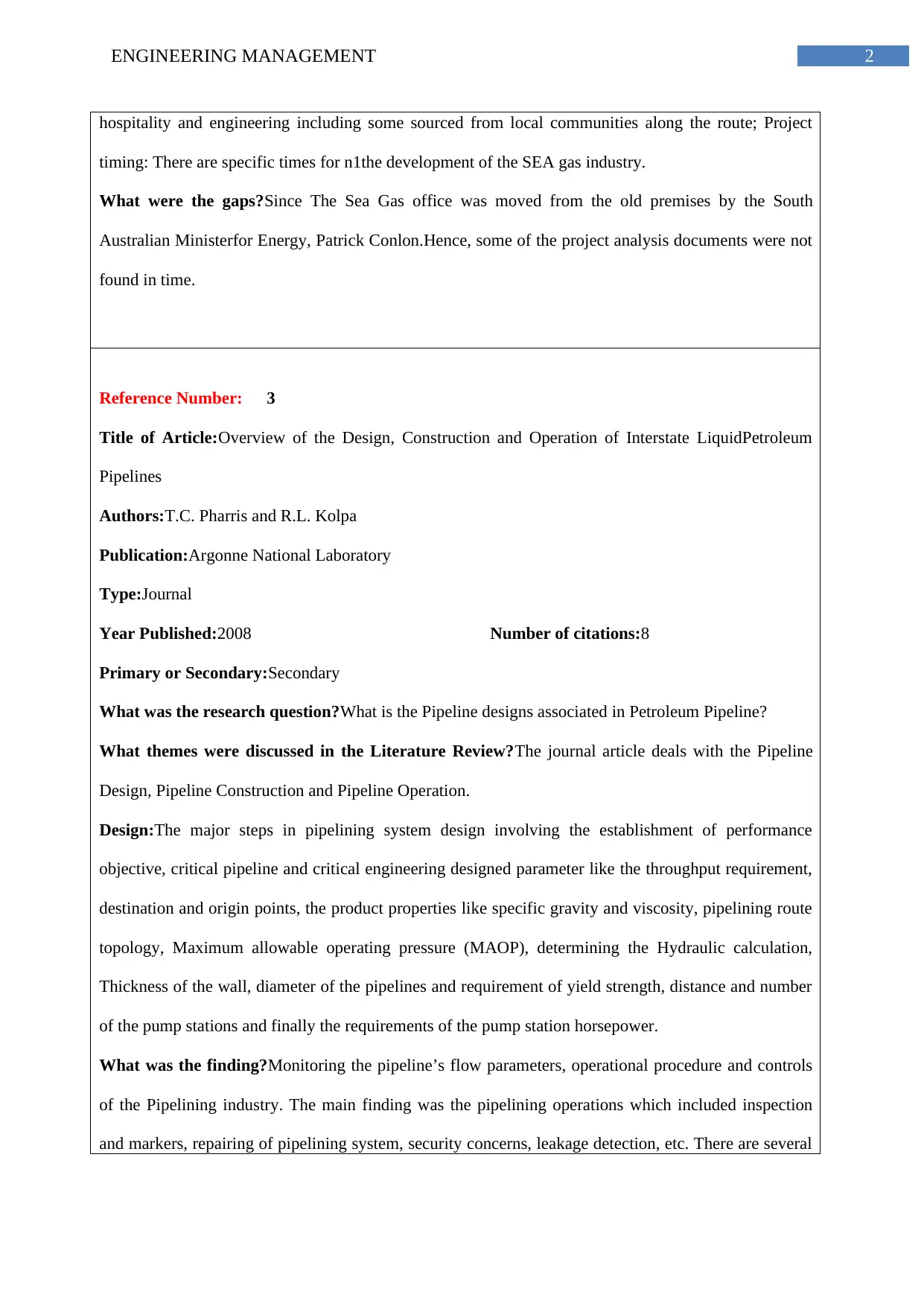
2ENGINEERING MANAGEMENT
hospitality and engineering including some sourced from local communities along the route; Project
timing: There are specific times for n1the development of the SEA gas industry.
What were the gaps?Since The Sea Gas office was moved from the old premises by the South
Australian Ministerfor Energy, Patrick Conlon.Hence, some of the project analysis documents were not
found in time.
Reference Number: 3
Title of Article:Overview of the Design, Construction and Operation of Interstate LiquidPetroleum
Pipelines
Authors:T.C. Pharris and R.L. Kolpa
Publication:Argonne National Laboratory
Type:Journal
Year Published:2008 Number of citations:8
Primary or Secondary:Secondary
What was the research question?What is the Pipeline designs associated in Petroleum Pipeline?
What themes were discussed in the Literature Review?The journal article deals with the Pipeline
Design, Pipeline Construction and Pipeline Operation.
Design:The major steps in pipelining system design involving the establishment of performance
objective, critical pipeline and critical engineering designed parameter like the throughput requirement,
destination and origin points, the product properties like specific gravity and viscosity, pipelining route
topology, Maximum allowable operating pressure (MAOP), determining the Hydraulic calculation,
Thickness of the wall, diameter of the pipelines and requirement of yield strength, distance and number
of the pump stations and finally the requirements of the pump station horsepower.
What was the finding?Monitoring the pipeline’s flow parameters, operational procedure and controls
of the Pipelining industry. The main finding was the pipelining operations which included inspection
and markers, repairing of pipelining system, security concerns, leakage detection, etc. There are several
hospitality and engineering including some sourced from local communities along the route; Project
timing: There are specific times for n1the development of the SEA gas industry.
What were the gaps?Since The Sea Gas office was moved from the old premises by the South
Australian Ministerfor Energy, Patrick Conlon.Hence, some of the project analysis documents were not
found in time.
Reference Number: 3
Title of Article:Overview of the Design, Construction and Operation of Interstate LiquidPetroleum
Pipelines
Authors:T.C. Pharris and R.L. Kolpa
Publication:Argonne National Laboratory
Type:Journal
Year Published:2008 Number of citations:8
Primary or Secondary:Secondary
What was the research question?What is the Pipeline designs associated in Petroleum Pipeline?
What themes were discussed in the Literature Review?The journal article deals with the Pipeline
Design, Pipeline Construction and Pipeline Operation.
Design:The major steps in pipelining system design involving the establishment of performance
objective, critical pipeline and critical engineering designed parameter like the throughput requirement,
destination and origin points, the product properties like specific gravity and viscosity, pipelining route
topology, Maximum allowable operating pressure (MAOP), determining the Hydraulic calculation,
Thickness of the wall, diameter of the pipelines and requirement of yield strength, distance and number
of the pump stations and finally the requirements of the pump station horsepower.
What was the finding?Monitoring the pipeline’s flow parameters, operational procedure and controls
of the Pipelining industry. The main finding was the pipelining operations which included inspection
and markers, repairing of pipelining system, security concerns, leakage detection, etc. There are several
Paraphrase This Document
Need a fresh take? Get an instant paraphrase of this document with our AI Paraphraser
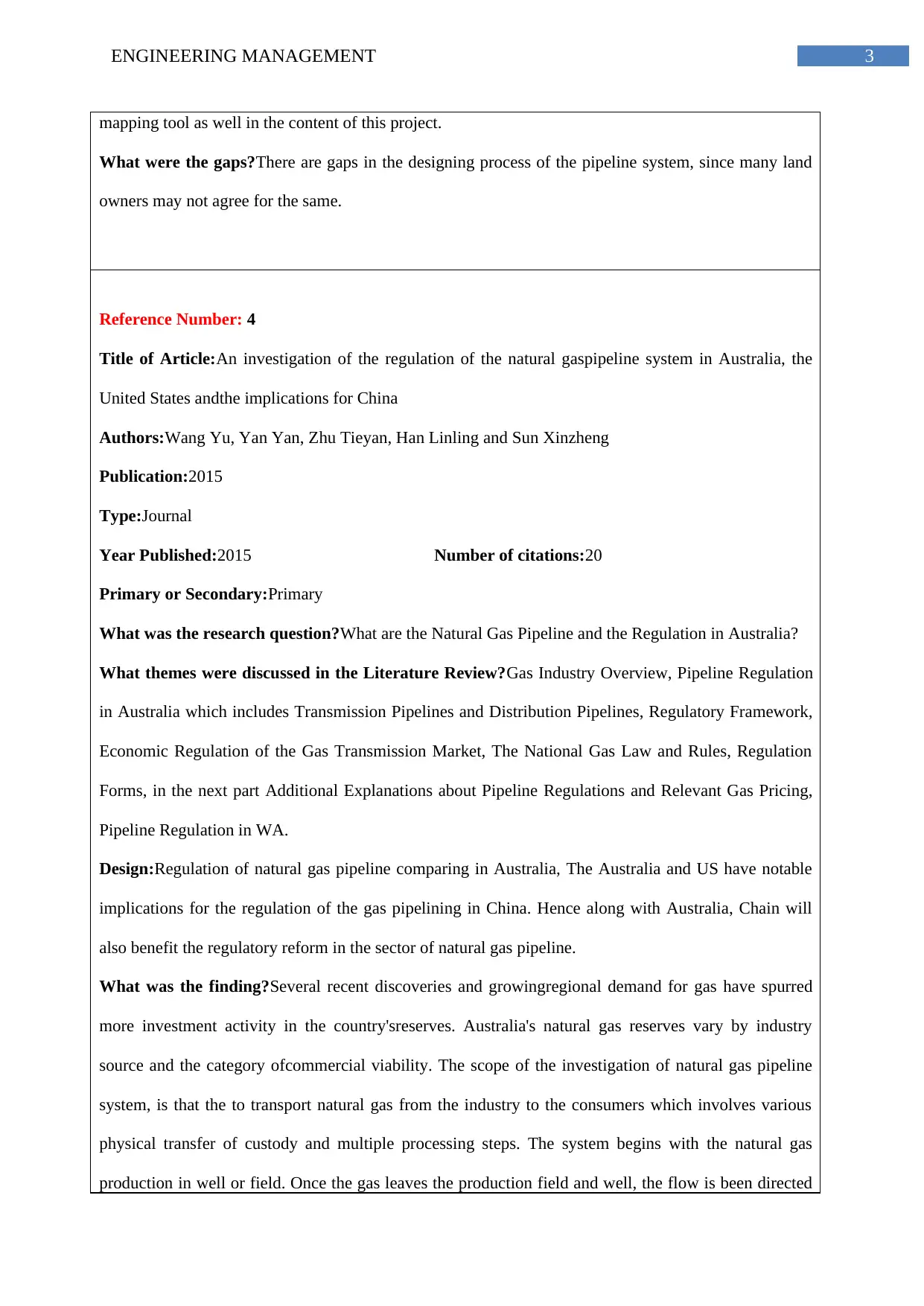
3ENGINEERING MANAGEMENT
mapping tool as well in the content of this project.
What were the gaps?There are gaps in the designing process of the pipeline system, since many land
owners may not agree for the same.
Reference Number: 4
Title of Article:An investigation of the regulation of the natural gaspipeline system in Australia, the
United States andthe implications for China
Authors:Wang Yu, Yan Yan, Zhu Tieyan, Han Linling and Sun Xinzheng
Publication:2015
Type:Journal
Year Published:2015 Number of citations:20
Primary or Secondary:Primary
What was the research question?What are the Natural Gas Pipeline and the Regulation in Australia?
What themes were discussed in the Literature Review?Gas Industry Overview, Pipeline Regulation
in Australia which includes Transmission Pipelines and Distribution Pipelines, Regulatory Framework,
Economic Regulation of the Gas Transmission Market, The National Gas Law and Rules, Regulation
Forms, in the next part Additional Explanations about Pipeline Regulations and Relevant Gas Pricing,
Pipeline Regulation in WA.
Design:Regulation of natural gas pipeline comparing in Australia, The Australia and US have notable
implications for the regulation of the gas pipelining in China. Hence along with Australia, Chain will
also benefit the regulatory reform in the sector of natural gas pipeline.
What was the finding?Several recent discoveries and growingregional demand for gas have spurred
more investment activity in the country'sreserves. Australia's natural gas reserves vary by industry
source and the category ofcommercial viability. The scope of the investigation of natural gas pipeline
system, is that the to transport natural gas from the industry to the consumers which involves various
physical transfer of custody and multiple processing steps. The system begins with the natural gas
production in well or field. Once the gas leaves the production field and well, the flow is been directed
mapping tool as well in the content of this project.
What were the gaps?There are gaps in the designing process of the pipeline system, since many land
owners may not agree for the same.
Reference Number: 4
Title of Article:An investigation of the regulation of the natural gaspipeline system in Australia, the
United States andthe implications for China
Authors:Wang Yu, Yan Yan, Zhu Tieyan, Han Linling and Sun Xinzheng
Publication:2015
Type:Journal
Year Published:2015 Number of citations:20
Primary or Secondary:Primary
What was the research question?What are the Natural Gas Pipeline and the Regulation in Australia?
What themes were discussed in the Literature Review?Gas Industry Overview, Pipeline Regulation
in Australia which includes Transmission Pipelines and Distribution Pipelines, Regulatory Framework,
Economic Regulation of the Gas Transmission Market, The National Gas Law and Rules, Regulation
Forms, in the next part Additional Explanations about Pipeline Regulations and Relevant Gas Pricing,
Pipeline Regulation in WA.
Design:Regulation of natural gas pipeline comparing in Australia, The Australia and US have notable
implications for the regulation of the gas pipelining in China. Hence along with Australia, Chain will
also benefit the regulatory reform in the sector of natural gas pipeline.
What was the finding?Several recent discoveries and growingregional demand for gas have spurred
more investment activity in the country'sreserves. Australia's natural gas reserves vary by industry
source and the category ofcommercial viability. The scope of the investigation of natural gas pipeline
system, is that the to transport natural gas from the industry to the consumers which involves various
physical transfer of custody and multiple processing steps. The system begins with the natural gas
production in well or field. Once the gas leaves the production field and well, the flow is been directed
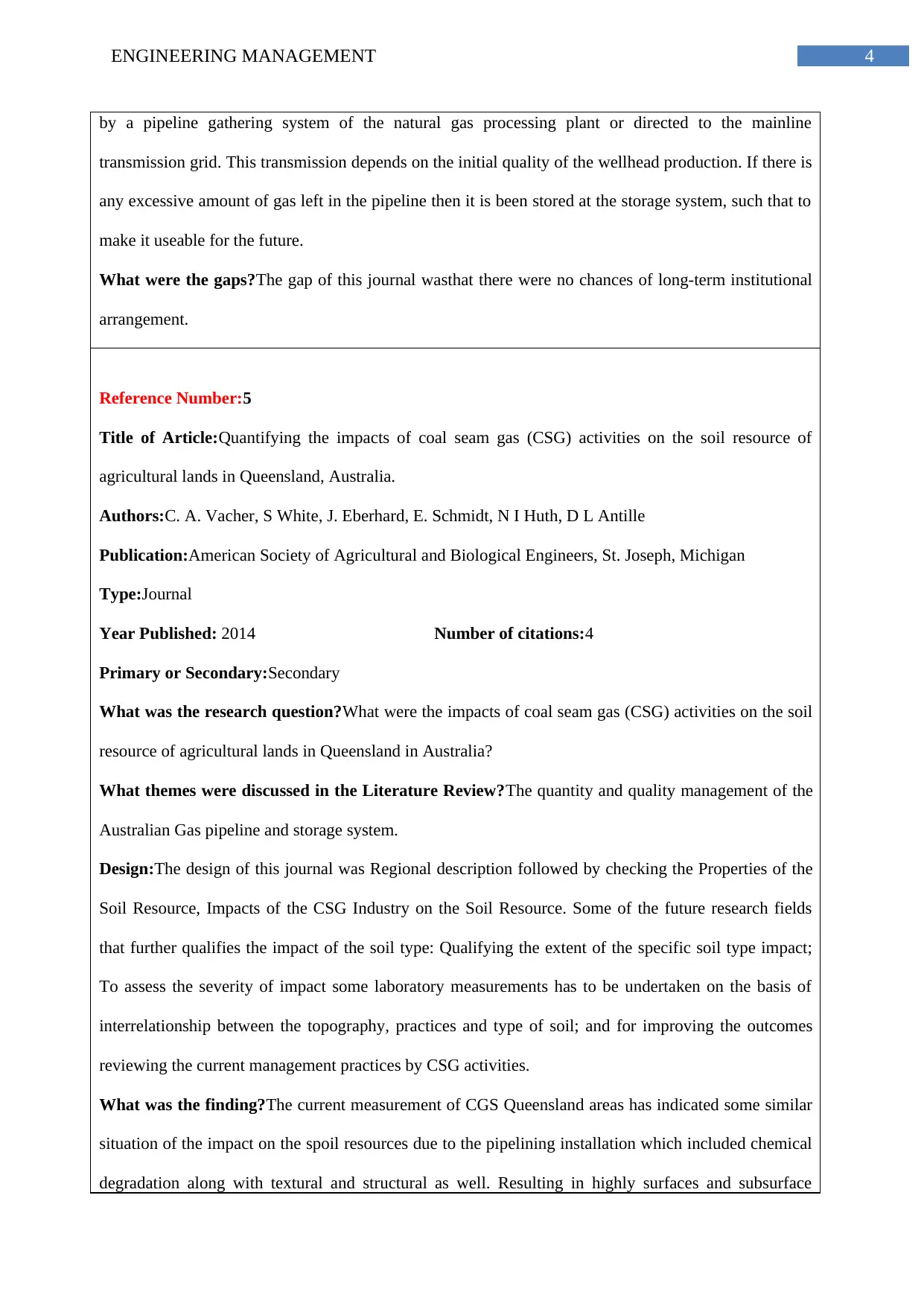
4ENGINEERING MANAGEMENT
by a pipeline gathering system of the natural gas processing plant or directed to the mainline
transmission grid. This transmission depends on the initial quality of the wellhead production. If there is
any excessive amount of gas left in the pipeline then it is been stored at the storage system, such that to
make it useable for the future.
What were the gaps?The gap of this journal wasthat there were no chances of long-term institutional
arrangement.
Reference Number:5
Title of Article:Quantifying the impacts of coal seam gas (CSG) activities on the soil resource of
agricultural lands in Queensland, Australia.
Authors:C. A. Vacher, S White, J. Eberhard, E. Schmidt, N I Huth, D L Antille
Publication:American Society of Agricultural and Biological Engineers, St. Joseph, Michigan
Type:Journal
Year Published: 2014 Number of citations:4
Primary or Secondary:Secondary
What was the research question?What were the impacts of coal seam gas (CSG) activities on the soil
resource of agricultural lands in Queensland in Australia?
What themes were discussed in the Literature Review?The quantity and quality management of the
Australian Gas pipeline and storage system.
Design:The design of this journal was Regional description followed by checking the Properties of the
Soil Resource, Impacts of the CSG Industry on the Soil Resource. Some of the future research fields
that further qualifies the impact of the soil type: Qualifying the extent of the specific soil type impact;
To assess the severity of impact some laboratory measurements has to be undertaken on the basis of
interrelationship between the topography, practices and type of soil; and for improving the outcomes
reviewing the current management practices by CSG activities.
What was the finding?The current measurement of CGS Queensland areas has indicated some similar
situation of the impact on the spoil resources due to the pipelining installation which included chemical
degradation along with textural and structural as well. Resulting in highly surfaces and subsurface
by a pipeline gathering system of the natural gas processing plant or directed to the mainline
transmission grid. This transmission depends on the initial quality of the wellhead production. If there is
any excessive amount of gas left in the pipeline then it is been stored at the storage system, such that to
make it useable for the future.
What were the gaps?The gap of this journal wasthat there were no chances of long-term institutional
arrangement.
Reference Number:5
Title of Article:Quantifying the impacts of coal seam gas (CSG) activities on the soil resource of
agricultural lands in Queensland, Australia.
Authors:C. A. Vacher, S White, J. Eberhard, E. Schmidt, N I Huth, D L Antille
Publication:American Society of Agricultural and Biological Engineers, St. Joseph, Michigan
Type:Journal
Year Published: 2014 Number of citations:4
Primary or Secondary:Secondary
What was the research question?What were the impacts of coal seam gas (CSG) activities on the soil
resource of agricultural lands in Queensland in Australia?
What themes were discussed in the Literature Review?The quantity and quality management of the
Australian Gas pipeline and storage system.
Design:The design of this journal was Regional description followed by checking the Properties of the
Soil Resource, Impacts of the CSG Industry on the Soil Resource. Some of the future research fields
that further qualifies the impact of the soil type: Qualifying the extent of the specific soil type impact;
To assess the severity of impact some laboratory measurements has to be undertaken on the basis of
interrelationship between the topography, practices and type of soil; and for improving the outcomes
reviewing the current management practices by CSG activities.
What was the finding?The current measurement of CGS Queensland areas has indicated some similar
situation of the impact on the spoil resources due to the pipelining installation which included chemical
degradation along with textural and structural as well. Resulting in highly surfaces and subsurface
⊘ This is a preview!⊘
Do you want full access?
Subscribe today to unlock all pages.

Trusted by 1+ million students worldwide
1 out of 19
Your All-in-One AI-Powered Toolkit for Academic Success.
+13062052269
info@desklib.com
Available 24*7 on WhatsApp / Email
![[object Object]](/_next/static/media/star-bottom.7253800d.svg)
Unlock your academic potential
Copyright © 2020–2025 A2Z Services. All Rights Reserved. Developed and managed by ZUCOL.